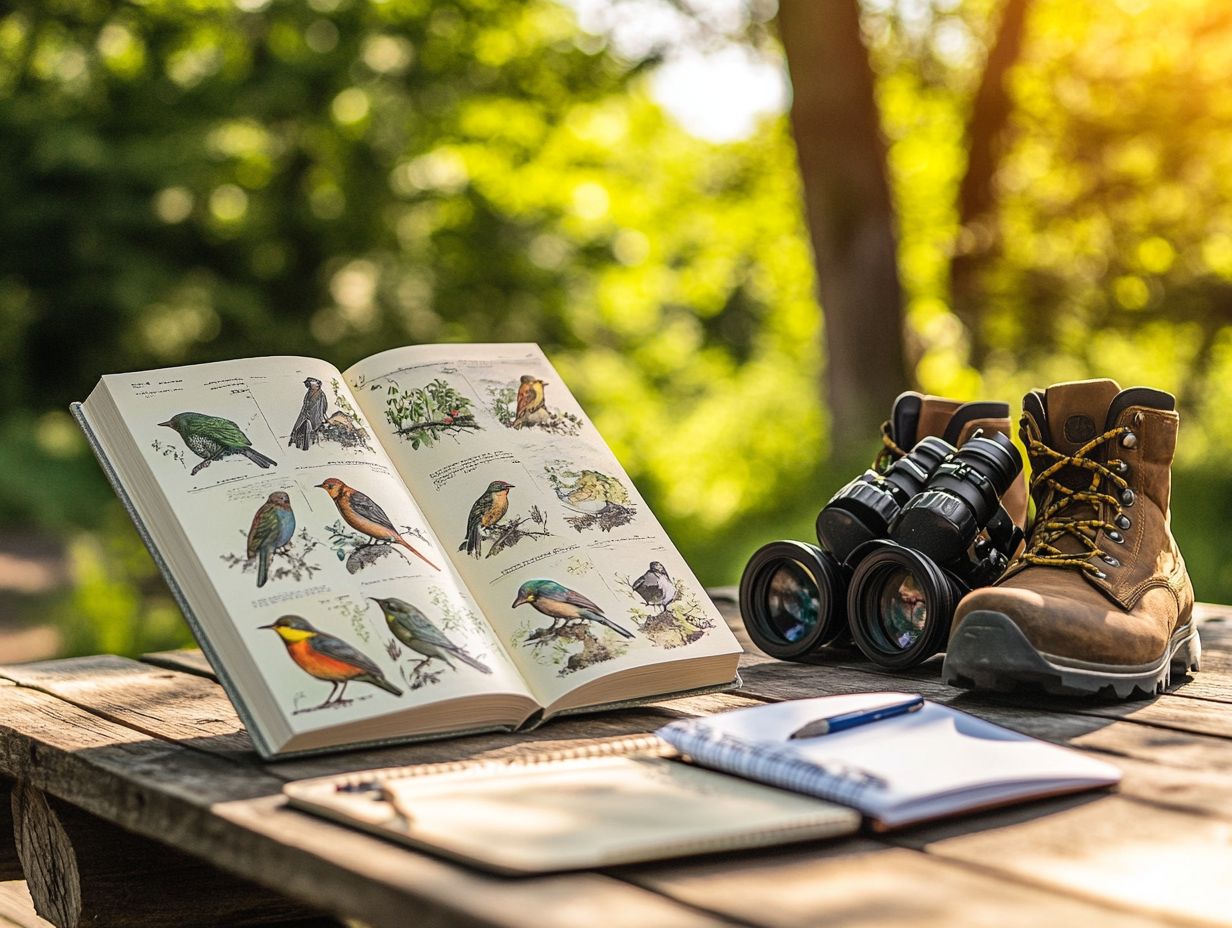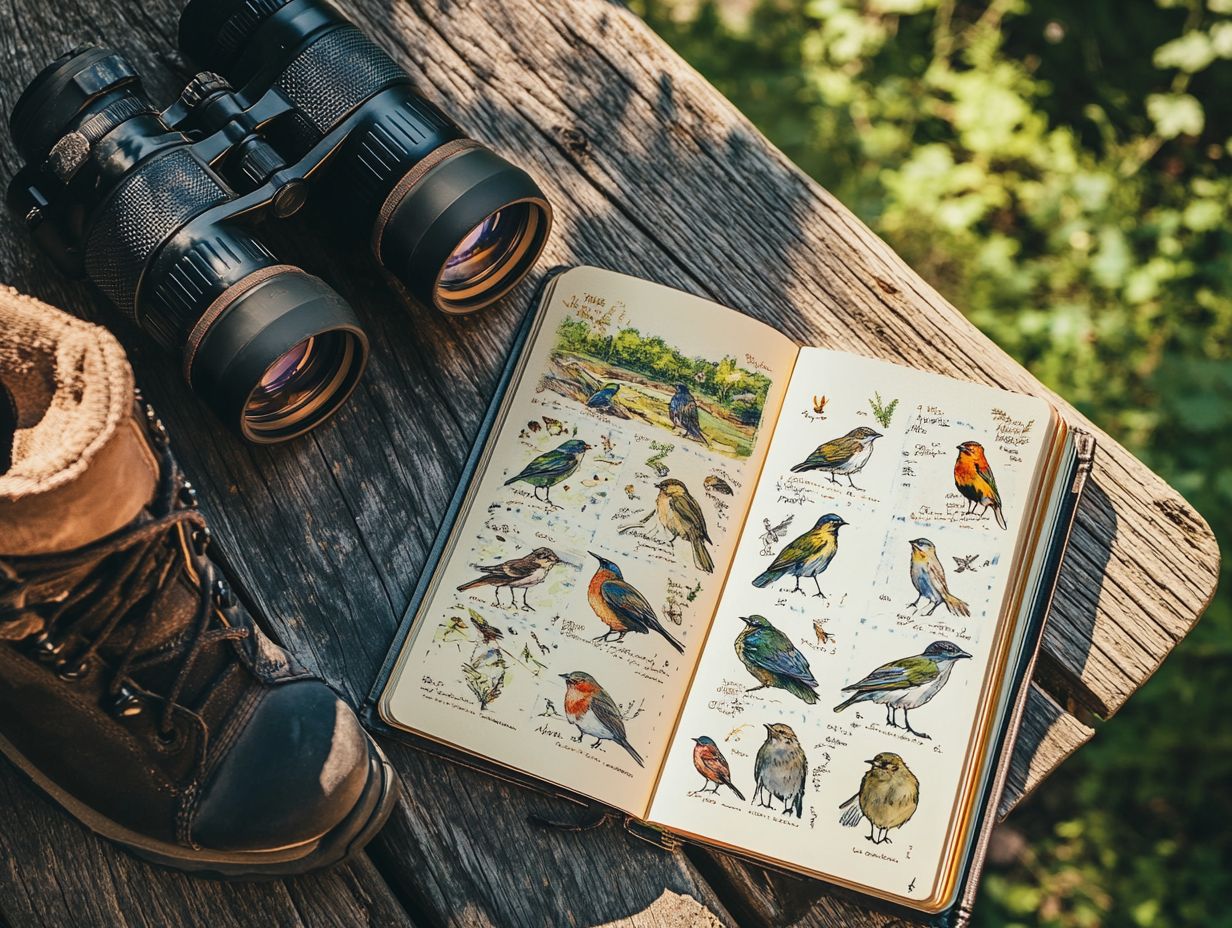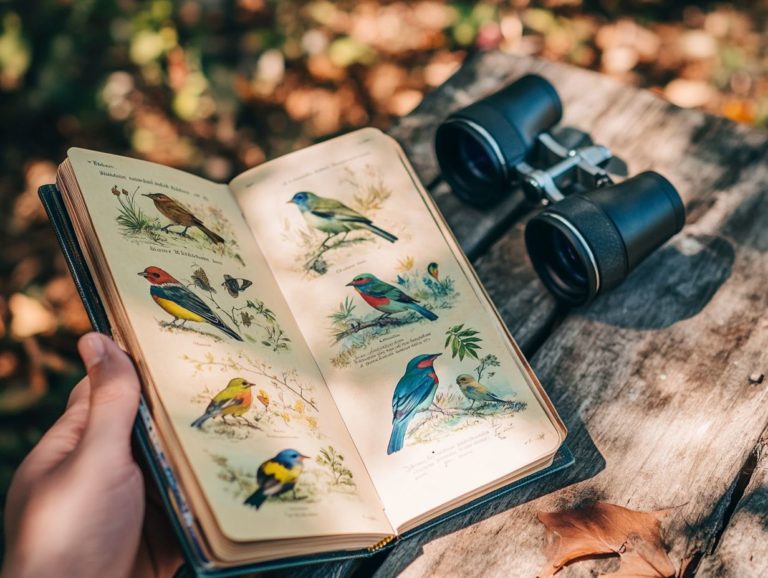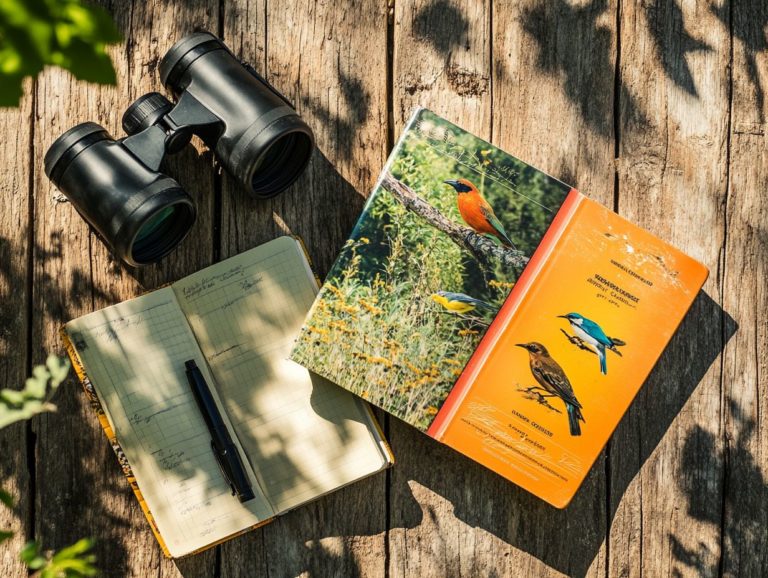Key Benefits of Using a Bird Field Guide
Bird watching is a fulfilling hobby that immerses you in the beauty of nature. But don t worry! Identifying various species can be incredibly rewarding and fun.
A bird field guide becomes an invaluable companion, whether you’re just starting out or have years of experience under your belt. This is especially true for those eager to explore the field guide family.
This article delves into the myriad benefits of utilizing a bird field guide. You will sharpen your bird identification skills, enhance your outdoor enjoyment, and experience the overall joy of bird-watching.
You’ll discover the various types of guides available, tips for selecting the one that best suits your needs, and effective strategies for making the most of it.
Regardless of whether you find yourself in the field or cozy at home, the right guide has the power to elevate your birding adventures to new heights while contributing to wildlife conservation.
Contents
Key Takeaways:

- A bird field guide can help you identify and learn about different bird species, enhancing your bird watching experience.
- Choose a bird field guide based on its format, whether printed or digital, and its coverage, either regional or comprehensive.
- To make the most of your bird field guide, follow tips such as maximizing identification and learning, and recording sightings and notes for future reference.
What is a Bird Field Guide?
A bird field guide is an invaluable resource for you, whether you’re an outdoor enthusiast or a dedicated naturalist. These guides are crafted to aid in bird identification and elevate your outdoor experiences, especially when using the most comprehensive bird field guides available.
No matter if you’re exploring the landscapes of Wisconsin, the expanses of Texas, or the rich biodiversity of Costa Rica, these guides offer illustrated descriptions and detailed information that make identifying various species a breeze.
They are essential tools for anyone passionate about wildlife conservation and nature exploration. The history of these guides is fascinating and can be traced back to the groundbreaking work of Roger Tory Peterson.
His innovative field guide transformed birdwatching in the 1930s by focusing on visual identification through exquisitely rendered illustrations. Subsequent contributions, like those from Ken Keffer, enriched the array and depth of birding resources available to you today.
Modern favorites like the Peterson Field Guide and the Sibley Guide remain essential. They provide you with comprehensive insights into habitats, behaviors, and vocalizations. For those looking to explore more options, popular bird field guides among experienced birders can further enrich your experience. With these resources in hand, you’re enabled to deepen your appreciation for the rich diversity of avian life that surrounds you.
Benefits of Using a Bird Field Guide
Utilizing a bird field guide presents a wealth of advantages for both novice and seasoned birdwatchers. These guides enhance your outdoor experience and deepen your connection to wildlife conservation while addressing the identification challenge, highlighting the importance of field guides in bird watching.
With illustrated descriptions and insights into natural phenomena, these guides enable you to appreciate the nuances of species identification. They allow you to engage more meaningfully in your birdwatching pursuits.
Identification and Learning
Bird identification using a field guide requires you to grasp key elements like field marks distinctive features that help identify bird species and visual identification techniques. These are essential skills for any dedicated birdwatcher.
Immersing yourself in bird clubs and local communities can significantly enhance your learning journey. These groups offer invaluable insights into the intricate art of identifying various species.
They often host workshops and field trips, providing you with the chance to observe birds in their natural habitats while benefiting from the guidance of seasoned members.
By honing in on specific characteristics like plumage color, beak shape, and flight patterns, you will sharpen your skills and deepen your appreciation for avian diversity, whether you re a novice or a seasoned watcher.
Sharing your findings and experiences not only fosters a sense of camaraderie but also encourages continual exploration, ultimately enriching your understanding of the remarkable world of birds.
Enhancing Bird Watching Experience
Enhancing your birdwatching hobby involves tapping into a wealth of resources, including bird field guides, to elevate your outdoor experience to new heights. By observing and understanding local wildlife populations, you can forge a deeper connection with nature, much like the inspirations drawn from naturalists such as Ken Keffer.
Picture yourself flipping through a well-worn field guide in a sun-drenched park. Your eyes catch the vibrant plumage of a nearby red-winged blackbird. These most useful field guides for travel birding offer essential identification tips and valuable insights into bird behavior and habitats, enabling you to anticipate their movements and interactions.
Consider a novice observer arriving at a tranquil lake just before dawn, equipped with a guide and an eager sense of curiosity. As they patiently wait, they might witness a pair of mallards engaging in a courtship display, turning an ordinary outing into an unforgettable experience.
These moments underscore the joy of leveraging knowledge to enrich your understanding of the environment. This way, every excursion becomes a unique and memorable adventure.
Types of Bird Field Guides

Bird field guides come in various formats, including printed editions and digital versions. Printed guides offer a hands-on feel, while digital guides provide convenience and easy access to features like search functions and multimedia content.
You can choose between regional guides, which explore the specific avian inhabitants of your area whether you’re in Wisconsin or Texas or comprehensive guides. These include a wide variety of bird species, enriching your exploration with valuable insights tailored to your adventures.
Printed Guides vs Digital Guides
The decision between printed and digital bird field guides ultimately hinges on your personal preferences and specific needs as an outdoor enthusiast. Printed guides provide a hands-on feel for bird identification, while digital guides offer convenience and accessibility on your adventures.
If you relish the sensation of flipping through pages and appreciate the simplicity of a physical book, printed guides can truly enhance your connection with nature. They re straightforward, requiring no batteries or screens elements that some might find less distracting.
Digital versions appeal to birdwatchers who enjoy technology, allowing you to carry an entire library in your pocket. With up-to-date information and interactive features, these guides can significantly enrich your birdwatching experience.
As you reflect on your habits whether you re trekking deep into the wilderness or simply enjoying a stroll in local parks it s worth weighing these aspects thoughtfully to choose the option that aligns perfectly with your unique style of nature exploration.
Regional vs Comprehensive Guides
When selecting a bird field guide, consider whether to opt for regional guides, which focus on specific wildlife populations in a particular area, or comprehensive guides that encompass a wider range of species across various regions. This choice can dramatically shape your birdwatching experience, influencing both your success in identification and overall enjoyment of the outdoors.
Regional guides are especially advantageous for dedicated birdwatchers exploring a specific habitat, like the wetlands of the Mississippi or the forests of the Pacific Northwest, where species are uniquely adapted to those environments. For example, the “Birds of Florida” guide offers detailed insights on local species, making it an ideal companion for enthusiasts in that state.
Comprehensive guides, such as the esteemed “National Geographic Field Guide to the Birds of North America,” offer valuable information on a vast array of species found across multiple habitats. This is particularly beneficial for those who frequently travel or embark on broader birdwatching expeditions, allowing you to identify a multitude of birds from different locations. To maximize your experience, it’s helpful to understand the layout of bird field guides without the burden of carrying several guides.
Understanding the nuances between these options will significantly enhance your joy of birdwatching and your ability to appreciate the natural phenomena that enrich our surroundings.
How to Choose the Right Bird Field Guide for You
Selecting the ideal bird field guide is essential for enhancing your outdoor experience and engaging in wildlife conservation. Considerations like your geographical location, expertise level, and specific interests in bird identification will greatly influence your decision, ensuring you choose the perfect companion for your birdwatching pursuits.
Factors to Consider
When choosing a bird field guide, several factors warrant your attention. The guide’s thoroughness, ease of use, and the specific bird species in your area are important to consider. As an outdoor enthusiast, evaluate your needs and preferences to select a guide that aligns with your birdwatching habits and identification goals.
High-quality illustrations are crucial, as they accurately depict species in various poses and plumage variations. Clear and concise text enhances your understanding, while relevant field marks like unique colors, shapes, and behaviors help you quickly distinguish between similar species.
Also, think about how the guide is organized whether it’s arranged by region, habitat, or taxonomy. A well-organized guide will make identifying birds in the field much smoother for you.
Tips for Using a Bird Field Guide Effectively

To make the most of a bird field guide, adopt strategies that enhance your identification accuracy and deepen your learning experience. Understanding the role of illustrations in bird field guides can significantly aid this process, while actively recording your sightings and notes for future reference is key.
These practices not only enrich your birdwatching endeavors but also play a vital role in wildlife conservation by helping track species populations.
Maximizing Identification and Learning
Maximizing your identification skills and learning with a bird field guide requires a systematic approach that blends observation techniques, an understanding of field marks, and the insightful illustrations the guide offers. This method enhances your outdoor experience and deepens your appreciation for the art of identifying various species.
To refine these skills, it s essential to practice regularly in diverse environments. Each setting offers unique challenges and valuable learning opportunities. Engaging with supplementary resources like online courses, apps, or local birding clubs can provide insights that enrich your knowledge and cultivate a sense of community among fellow enthusiasts.
By actively participating in discussions and sharing your experiences, you ll discover new perspectives and tips that enhance your species identification abilities. Consistent practice, combined with these resources, will build your confidence and improve your overall recognition skills, leading to a more rewarding birdwatching experience.
Recording Sightings and Notes
Recording sightings and notes is a fun and rewarding practice for you as a birdwatcher. It allows you to document wildlife populations and enhances your understanding of bird behavior. This practice makes birdwatching more enjoyable. It also helps conservation efforts by giving important information about where birds live and how they behave.
By carefully noting the dates, locations, and specific behaviors of the birds you encounter, you contribute meaningful insights into shifts in migration patterns and habitat use. To keep your records efficient and organized, consider using a dedicated notebook or a digital app that allows you to categorize entries by date and location for easy access.
Taking the time to include details like weather conditions or interactions with other wildlife will deepen your understanding and create a richer resource for future study. This organized approach aids your personal learning and informs conservation initiatives, making every sighting a meaningful step toward better protection of bird species.
Frequently Asked Questions
What is a bird field guide?
A bird field guide is a reference book or mobile application that provides information on different species of birds, including their physical characteristics, behavior, and habitat.
Ready to start birdwatching? Explore your local birding community and find the perfect guide for your adventures!
What are the key benefits of using a bird field guide?

A bird field guide can enhance your birdwatching experience by understanding bird behavior. It helps you identify and learn about the birds you encounter.
This guide also supports conservation efforts by providing information on endangered species.
Are there different types of bird field guides?
Yes! You can find printed guides, digital versions, and even audio guides. Each type offers unique advantages like convenience and portability.
Can I use a bird field guide even if I’m not an experienced birder?
Absolutely! These guides are for everyone, from beginners to experts. They include helpful tips and illustrations to make bird identification easy.
How can a bird field guide help in bird photography?
A field guide assists in identifying and locating specific bird species, and exploring the benefits of birding with mobile apps can make it even easier to capture high-quality photos.
It also provides insights into a bird’s behavior, so you can predict its movements.
Is a bird field guide only useful for birdwatching?
No! It’s a valuable resource for bird experts, researchers, and anyone interested in birds. The guide has detailed information on species, making it useful for various purposes.






